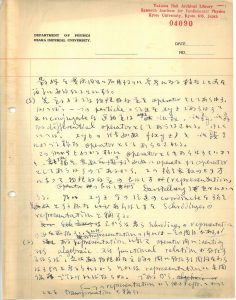Archive of historical materials

From Quantum Mechanics to Relativistic Quantum Mechanics
OU1936-A1 (49 pages) Date: None
This paper was filed in the year 1936 folder, but it has no date on it. In this paper, Yukawa starts describing the basics of quantum mechanics and many-body system and then moves on to the subject of the structural composition of relativistic quantum mechanics. Although it is written in a lecture note style, it is not known whether Yukawa gave a lecture based on this paper or wrote the paper just for the sake of deepening his own thoughts. The second and subsequent pages are written on both sides of note paper printed with “Osaka Imperial University, Department of Science.”
Yukawa starts the paper by writing that in quantum mechanics, physical quantities are expressed by the operators and that they became non-commutative values. The topic of discussion moves to quantum mechanics of many-body systems, but a memo used to organize the basic problems pertaining to the structure of the atomic nucleus was inserted (in page 8) before discussing that topic. Yukawa goes back to the basic principles of quantum mechanics and talks about the generalization of basic (canonical) commutation relations as relativistic relations. That was the problem that troubled all physicists in those years. According to Einstein’s theory of relativity, space and time coordinates are mixed together in the Lorentz transformation. Nevertheless, time plays a special role in quantum mechanics. Can the basic commutation relations including time be regarded relativistically as universal relationships? Yukawa conducts in-depth examination in the 10 pages from about page 20. Then, he proceeds to the discussion on the operator relations of 4×4 matrices according to the Dirac theory. On page 37, Yukawa reattempts the relativistic generalization of canonical equations in quantum mechanics, but to no avail. From page 45, he develops the idea of treating a field as an operator. He sets either same-time commutation relation or anticommutation relation depending on whether it is a boson or fermion, and then he describes the temporal development based on the commutation relation with the Hamiltonian. On the last four pages, Yukawa jotted down detailed calculations. Yukawa was very close to formulating the quantum field theory. As indicated by this note and historical material OU1935-B9, Yukawa was seeking to formulate the relativistic quantum field theory by trials and errors. (Written by Yutaka Hosotani)


